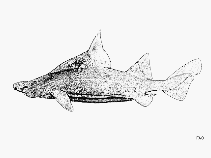http://www.fishbase.org/Summary/speciesSummary.php?genusname=Oxynotus&speciesname=bruniensis ---> http://52.67.158.155/Summary/speciesSummary.php?genusname=Oxynotus&speciesname=bruniensis
http://52.67.158.155/Summary/speciesSummary.php?genusname=Oxynotus&speciesname=bruniensis ---> https://fishbase.net.br/Summary/speciesSummary.php?genusname=Oxynotus&speciesname=bruniensis
https://fishbase.net.br/Summary/speciesSummary.php?genusname=Oxynotus&speciesname=bruniensis ---> https://fishbase.net.br/summary/Oxynotus-bruniensis.html
Oxynotus bruniensis, Prickly dogfish

You can
sponsor
this page
Common name (e.g. trout)
Genus + Species (e.g. Gadus morhua)
-

-
About this page
-
Languages
-
User feedbacks
-
Citation
-
Uploads
-
Related species
-


 Prickly dogfish
Add your observation in
Fish Watcher
Upload your
photos
and
videos
Prickly dogfish
Add your observation in
Fish Watcher
Upload your
photos
and
videos
Pictures
|
Google image
 Oxynotus bruniensis
Oxynotus bruniensis
Picture by
FAO
Elasmobranchii (sharks and rays) >
Squaliformes
(Sleeper and dogfish sharks) >
Oxynotidae
(Rough sharks)
Etymology:
Oxynotus:
oxys
(Gr.), sharp;
notos
(Gr.), back, referring to its keeled back (“dorso carenato”). (
See ETYFish
)
;
bruniensis:
-ensis
, Latin suffix denoting place: the shore of Bruny Island, Tasmania, where holotype was discovered in a “dried … but fair state of preservation”. (
See ETYFish
)
.
More on author:
Ogilby
.
Environment: milieu / climate zone / depth range / distribution range
Ecology
Marine; bathydemersal; depth range 45 - 1070 m (Ref.
26346
), usually 350 - 650 m (Ref.
6871
). Deep-water; 31°S - 55°S, 125°E - 172°W (Ref.
54691
)
Southwest Pacific: confined to temperate waters off southern Australia and New Zealand.
Length at first maturity / Size / Weight / Age
Maturity: L
m
?
, range 60 - ? cm
Max length : 65.0 cm TL male/unsexed; (Ref.
122636
); 74.0 cm TL (female); max. published weight: 6.6 kg (Ref.
122636
)
Anal
spines
: 0;
Anal
soft rays
: 0. Uniform grey-brown coloration; short, blunt snout; high sail-like dorsal fins with spines and broad apices, first dorsal spine inclined backward; high, thick triangular body with large, rough denticles; circular spiracles; lanceolate upper teeth, lower blade-like teeth in less than 12 rows (Ref.
247
).
Found on outer continental and insular shelves and uppermost slopes (Ref.
247
). Probably feeds on bottom invertebrates and fishes. Ovoviviparous (Ref.
205
). Taken incidentally with bottom trawls but probably not used (Ref.
247
).
Ovoviviparous, with 7 young in a litter (Ref.
247
). Size at birth about 24 cm (Ref.
6871
). Distinct pairing with embrace (Ref.
205
).
Compagno, L.J.V.
, 1984. FAO Species Catalogue. Vol. 4. Sharks of the world. An annotated and illustrated catalogue of shark species known to date. Part 1 - Hexanchiformes to Lamniformes. FAO Fish. Synop. 125(4/1):1-249. Rome, FAO. (Ref.
247
)
IUCN Red List Status (Ref.
130435
)
Near Threatened (NT)
(A2d); Date assessed:
07 July 2017
CITES
Not Evaluated
Not Evaluated
Threat to humans
Harmless
Human uses
Fisheries: of no interest
FAO - Fisheries:
species profile
; Publication:
search
|
FishSource
|
More information
Countries
FAO areas
Ecosystems
Occurrences
Introductions
Stocks
Ecology
Diet
Food items
Food consumption
Ration
Common names
Synonyms
Metabolism
Predators
Ecotoxicology
Reproduction
Maturity
Spawning
Spawning aggregation
Fecundity
Eggs
Egg development
Age/Size
Growth
Length-weight
Length-length
Length-frequencies
Morphometrics
Morphology
Larvae
Larval dynamics
Recruitment
Abundance
BRUVS
References
Aquaculture
Aquaculture profile
Strains
Genetics
Electrophoreses
Heritability
Diseases
Processing
Nutrients
Mass conversion
Collaborators
Pictures
Stamps, Coins Misc.
Sounds
Ciguatera
Speed
Swim. type
Gill area
Otoliths
Brains
Vision
Tools
E-book
|
Field guide
|
Length-frequency wizard
|
Life-history tool
|
Point map
|
Classification Tree
|
Catch-MSY
|
Special reports
Check for Aquarium maintenance
|
Check for Species Fact Sheets
|
Check for Aquaculture Fact Sheets
Download XML
Summary page
|
Point data
|
Common names
|
Photos
Internet sources
AFORO (otoliths) |
Aquatic Commons
|
BHL
|
Cloffa
|
BOLDSystems
|
Websites from users
|
Check FishWatcher
|
CISTI
|
Catalog of Fishes
:
genus
,
species
|
DiscoverLife
|
ECOTOX
| FAO - Fisheries:
species profile
; Publication:
search
|
Faunafri
| Fishipedia |
Fishtrace
| GenBank:
genome
,
nucleotide
|
GloBI
|
Google Books
|
Google Scholar
|
Google
| IGFA World Record |
MitoFish
|
Otolith Atlas of Taiwan Fishes
|
PubMed
| Reef Life Survey | Socotra Atlas |
Tree of Life
| Wikipedia:
Go
,
Search
| World Records Freshwater Fishing |
Zoological Record
Estimates based on models
Preferred temperature (Ref.
123201
): 6.2 - 10.4, mean 8 °C (based on 150 cells).
Phylogenetic diversity index (Ref.
82804
): PD
50
= 0.5625 [Uniqueness, from 0.5 = low to 2.0 = high].
Bayesian length-weight: a=0.00372 (0.00160 - 0.00860), b=3.15 (2.94 - 3.36), in cm total length, based on LWR estimates for this (Sub)family-body shape (Ref.
93245
).
Trophic level (Ref.
69278
): 4.0 ±0.62 se; based on food items.
Resilience (Ref.
120179
): Very Low, minimum population doubling time more than 14 years (Fec=7).
Fishing Vulnerability (Ref.
59153
): Moderate to high vulnerability (50 of 100).
Nutrients (Ref.
124155
): Calcium = 8.32 [1.56, 44.88] mg/100g; Iron = 0.283 [0.065, 0.939] mg/100g; Protein = 18.8 [17.0, 20.6] %; Omega3 = 0.302 [0.100, 0.969] g/100g; Selenium = 14.1 [4.0, 44.8] μg/100g; VitaminA = 13.4 [2.6, 67.1] μg/100g; Zinc = 0.414 [0.198, 0.828] mg/100g (wet weight);
Back to Search
Random Species
Back to Top
Accessed through:
Not available
FishBase mirror site :
Laguna, Philippines
Page last modified by :
mrius-barile
|